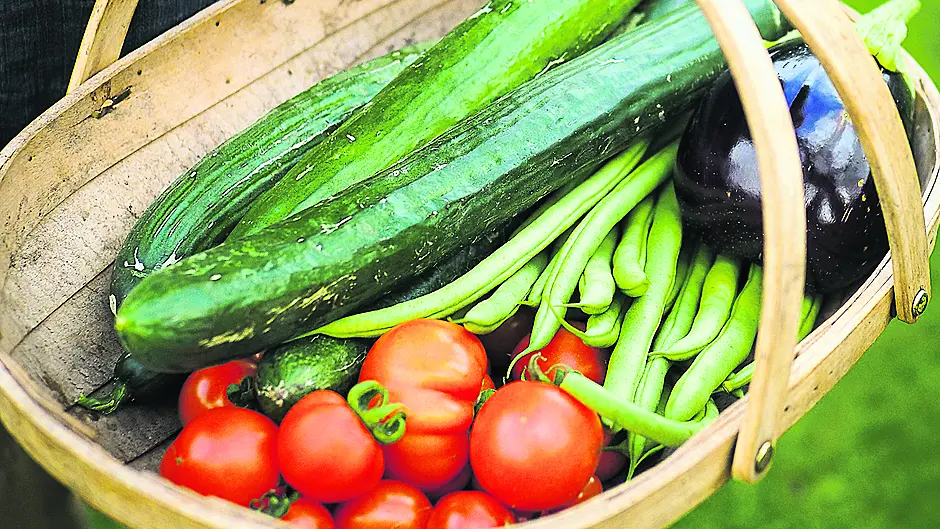By Joyce Russell
THE long spell of hot weather brought some plants to maturity faster than usual. Many flowers are a few weeks earlier than in an average summer and a period of drought can make the flowering period shorter.
Heavy rain was welcome, of course, and eased the burden of watering even if it flattened flower borders a little.
Early potato crops have made an excellent clean harvest, but keep an eye on maincrop ones for signs of blight. You might be surprised at how many potatoes plants have already produced, so do lift one or two and check how they are doing.
You may lift the lot a couple of weeks earlier than usual and still get plenty to store for the winter.
Peppers
These sun-loving plants can produce very well in a hot dry summer. A greenhouse or polytunnel is usually advised, but plants can crop well in a sheltered position outdoors if your garden is a sun trap. You can also grow a few plants in large pots in a conservatory or near a sunny window – this allows you to move plants in and out of the house as the weather changes.
You need to keep soil watered and give stems a light shake to help pollinate flowers. Use sticks to support plants – branches can break if they bear a heavy crop. Use a liquid feed every seven-10 days while fruits are swelling and you should be enjoying the first fruits this month.
Sun helps fruits to ripen to a full colour. This leads to a sweeter flavour in ‘sweet’ varieties, or to more heat if you are growing chillies.
Enjoy the bounty
There is lots to pick in the greenhouse now and there is lots to harvest in the outdoor garden too. You may be overwhelmed by the glut, so get out your recipe books and make sure you have all the vinegar, sugar and spices you need for making pickles, jams and preserves. Gather together lots of clean jars and containers. Ask friends and neighbours to save them for you. You are going to need these as the garden just keeps on producing.
There should be plenty of tomatoes ripening in the greenhouse and this has been a good year so far for outdoor varieties. Sun-ripened fruit has an unbeatable flavour so don’t pick too early.
Cucumbers can grow long and straight or they can curl into a C shape. Some will be short and stubby and some varieties are covered in sharp bumps.
All taste good, so go by that as the important factor rather than how they look. If you have grown a ridge variety, rub over the spines that bump up from the skin – it’s very easy to smooth things down.
Don’t worry if the main stem of a cucumber plant fails – there will usually be a few side shoots lower down the stem and these will grow on to produce fruit even if you have to remove the main stem.
Winter greens
Plants may seem small and not very exciting, but it is important to look after the
broccoli, kale, Brussels sprouts, cabbages and cauliflowers. These will grow to be the core of your winter garden eating.
Provide stakes for any tall plants, but take care to avoid the leaf joints where sprouts will grow when tying in Brussels sprout stems. Keep plants watered in dry weather ¬ – they need to put on plenty of growth now if you want to start picking in late autumn.
Sweet peas
These fabulously fragrant flowers can spread their scent around your garden. Keep picking flowers and remove seed pods if you want plants to keep flowering for longer. Bunches last a few days in a vase, so expect to go and pick more as needed.
Keep an eye on stems and supports. Delicate tendrils twist around sticks to hold stems upright. They won’t do a very secure job around a thick pole and stems can slide or bend over. Use string to tie any drooping stems before they break. And if strong winds are forecast, you may want to run more strings around the frame to keep the whole display as upright as possible.
Sweetcorn
I always devote more polytunnel space to this crop than I possibly should, but it is always a winner. Picking the first cobs and sitting down to share them with family is a special moment each year. There’s nothing quite like the flavour of a fresh picked golden cob that is into boiling water as soon as it is picked and stripped. Boil for four minutes only then drain and serve with butter, salt and pepper. You don’t need anything more, although a set of corn cob holders and curved dishes to allow for rolling in butter do make the whole experience super special.










